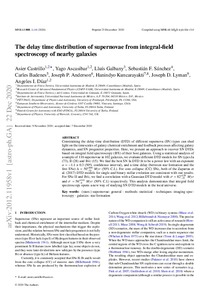The delay time distribution of supernovae from integral-field spectroscopy of nearby galaxies
Sanchez Sebastián F; Lyman Joseph D; Castrillo Asier; Díaz Angeles I; Badenes Carles; Galbany Lluís; Ascasibar Yago; Anderson Joseph P; Kuncarayakti Hanindyo
The delay time distribution of supernovae from integral-field spectroscopy of nearby galaxies
Sanchez Sebastián F
Lyman Joseph D
Castrillo Asier
Díaz Angeles I
Badenes Carles
Galbany Lluís
Ascasibar Yago
Anderson Joseph P
Kuncarayakti Hanindyo
OXFORD UNIV PRESS
Julkaisun pysyvä osoite on:
https://urn.fi/URN:NBN:fi-fe2021042822722
https://urn.fi/URN:NBN:fi-fe2021042822722
Tiivistelmä
Constraining the delay time distribution (DTD) of different supernova (SN) types can shed light on the time-scales of galaxy chemical enrichment and feedback processes affecting galaxy dynamics, and SN progenitor properties. Here, we present an approach to recover SN DTDs based on integral-field spectroscopy (IFS) of their host galaxies. Using a statistical analysis of a sample of 116 SNe in 102 galaxies, we evaluate different DTD models for SN types Ia (73), II (28), and Ib/c (15). We find the best SN Ia DTD fit to be a power law with an exponent α = -1.1 +/- 0.3 (50 per cent confidence interval (C.I.)), and a time delay (between star formation and the first SNe) Δ = 50-35+100 Myr (50 per cent C.I.). For core collapse (CC) SNe, both of the Zapartas et al. DTD models for single and binary stellar evolution are consistent with our results. For SNe II and Ib/c, we find a correlation with a Gaussian DTD model with σ = 82-23+129 Myr and σ = 56-9+141 Myr (50 per cent C.I.), respectively. This analysis demonstrates that IFS opens a new way of studying SN DTD models in the local Universe.
Kokoelmat
- Rinnakkaistallenteet [19207]
